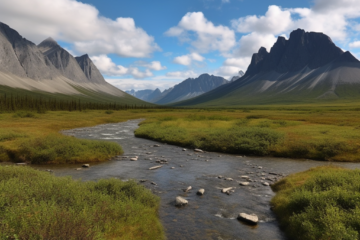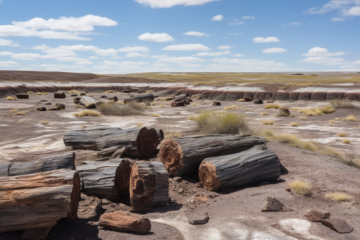You’ve packed your car, plotted your route, and you’re ready to escape into nature’s embrace. But wait—are you truly prepared for the adventure ahead? Years of car camping have taught me that the difference between a memorable trip and a miserable one often comes down to having the right gear. The essentials I’m about to share will transform your outdoor experience from basic survival to pure enjoyment.
High-Quality Tent With Proper Ventilation
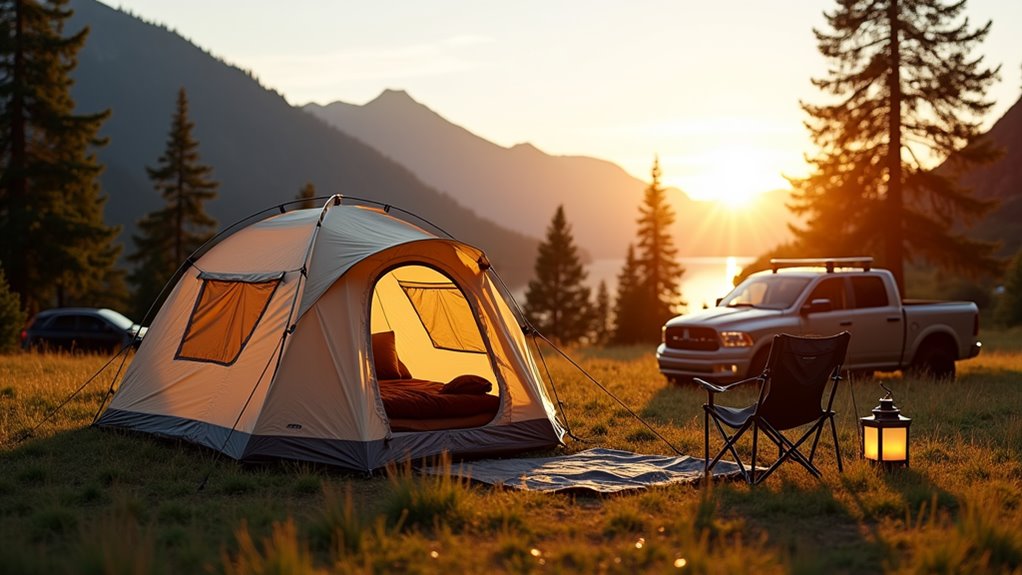
When you’re settling in for the night after a long day of exploring, your tent becomes your sanctuary—and nothing ruins that faster than waking up in a pool of condensation or gasping for fresh air.
You’ll want a tent with mesh panels, adjustable vents, and a rainfly that doesn’t seal you in like a plastic bag. Look for double-wall designs that create an air gap between you and the elements.
Position vents at both high and low points to establish natural airflow. Don’t skimp on quality—weatherproof zippers, sealed seams, and ripstop fabric mean the difference between cozy nights and miserable ones.
A well-ventilated four-season tent handles temperature swings better than any bargain shelter ever could.
Sleeping Bags Rated for Expected Temperatures
Temperature ratings aren’t just numbers on a label—they’re the difference between restful sleep and a night spent shivering in your sleeping bag, counting the hours until dawn.
You’ll need to match your bag’s rating to the coldest temperatures you’ll encounter. Check weather forecasts, but remember mountain temperatures can plummet unexpectedly.
Don’t trust comfort ratings—they’re often optimistic. Instead, choose bags rated 10-15 degrees below expected lows. You’ll appreciate that buffer when cold fronts roll through.
Consider your metabolism too; if you’re naturally cold, go even warmer.
For three-season camping, a 20-30°F bag hits the sweet spot. Add a liner for extra warmth without buying multiple bags.
Remember: you can always unzip when warm, but you can’t create insulation that isn’t there.
Portable Camping Chairs
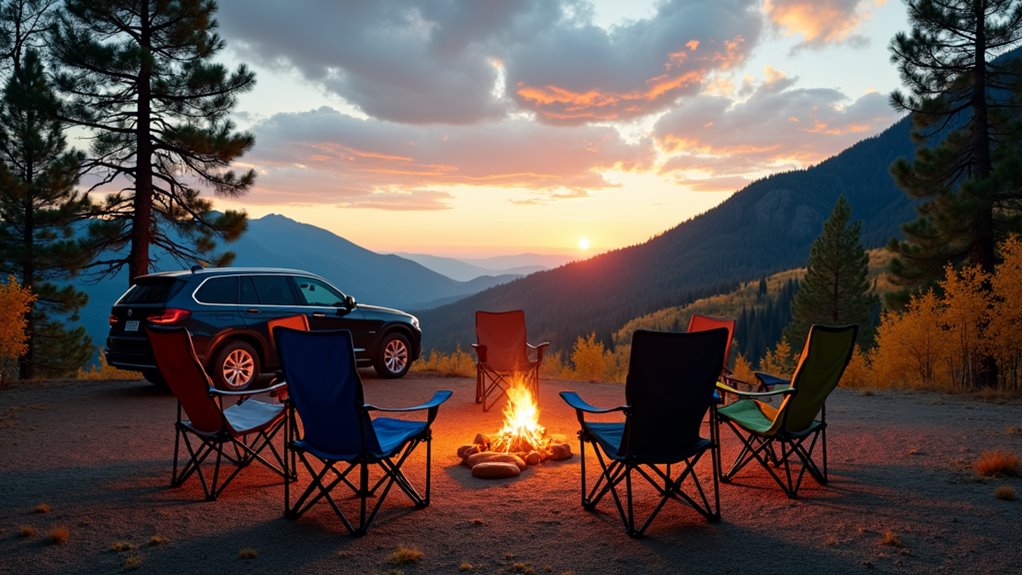
After eight hours behind the wheel, your body craves more than just standing and stretching—you need a proper seat that supports your back while you soak in the campfire’s warmth.
Skip those flimsy discount chairs that’ll leave you aching. Instead, invest in models with padded armrests, breathable mesh backs, and weight ratings above 250 pounds. You’ll appreciate the difference when you’re still comfortable after sunset.
Look for chairs with carrying bags and shoulder straps—you’ll haul them everywhere. Cup holders aren’t luxuries; they’re necessities for morning coffee and evening beverages.
Test the setup mechanism before buying. If it takes more than thirty seconds to unfold, you’ll hate it by day three. Quality brands like REI Co-op and Helinox cost more upfront but survive years of weekend adventures.
Reliable Cooler With Extended Ice Retention
Your food safety and drink temperature depend entirely on choosing the right cooler, yet most car campers grab whatever’s on sale without understanding ice retention basics.
You’ll need a rotomolded cooler with at least two inches of insulation to maintain ice for three-plus days. Look for rubber gaskets that create an airtight seal and heavy-duty latches that won’t fail under pressure.
Pre-chill your cooler overnight before loading it. Use a 2:1 ice-to-contents ratio, and layer block ice on bottom with cubed ice filling gaps.
You’re wasting money on premium coolers if you’re not pre-cooling beverages and freezing meals beforehand. Position your cooler in shade, cover it with a wet towel, and limit opening frequency.
These techniques transform a decent cooler into an ice-preserving powerhouse.
Camp Stove and Cooking Essentials
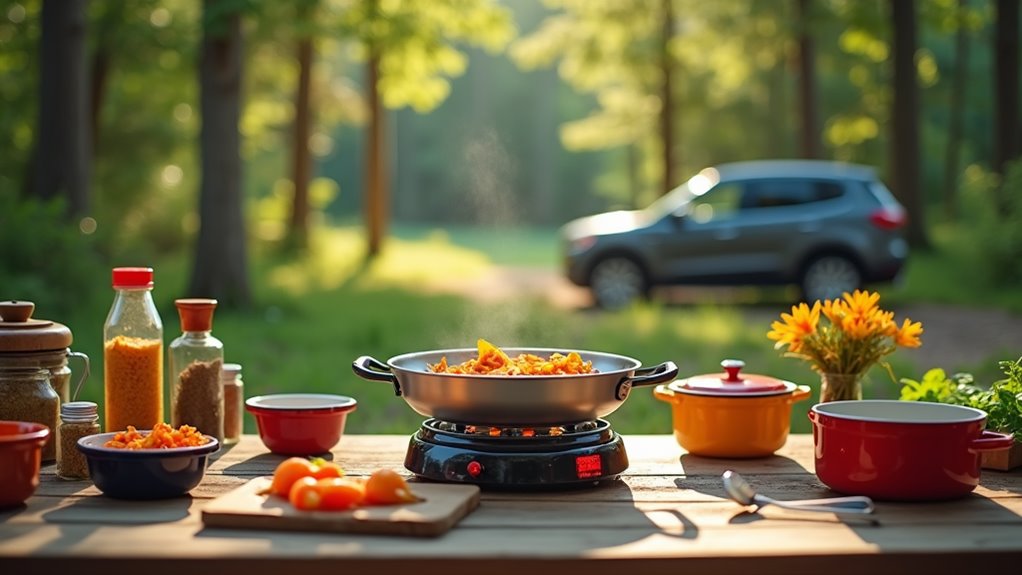
While a reliable cooler keeps your food fresh, you’ll need a dependable camp stove to transform those ingredients into satisfying meals. Choose a two-burner propane stove that’ll handle everything from morning coffee to elaborate dinners. You’ll appreciate the stability and wind resistance when cooking outdoors.
Pack a lightweight cookset with nesting pots, a cast-iron skillet for perfect sears, and a collapsible kettle. Don’t forget essentials: a sharp knife, cutting board, spatula, and can opener.
You’ll want plates and bowls that won’t shatter, plus insulated mugs for hot beverages. Bring biodegradable soap, a scrub sponge, and microfiber towels for cleanup.
Store spices in a compact organizer and pre-measure ingredients at home. With proper cooking gear, you’ll create memorable meals that rival your home kitchen.
Water Storage and Filtration System
Clean water remains the foundation of any successful camping trip, and you’ll need both reliable storage containers and backup purification methods.
You’ll want collapsible water jugs that won’t crack in cold weather or leak during transport. I’ve found 5-gallon BPA-free containers work perfectly for car camping—they’re manageable to carry yet hold enough for cooking and drinking.
Don’t rely solely on campground water. Pack a gravity-fed filter or portable purifier as insurance against questionable sources. The Sawyer Mini threads directly onto bottles and filters 100,000 gallons—it’s saved me countless times.
Add water purification tablets to your kit; they weigh nothing but provide peace of mind. Store everything in a dedicated bin to prevent contamination from other gear.
Comprehensive First Aid Kit
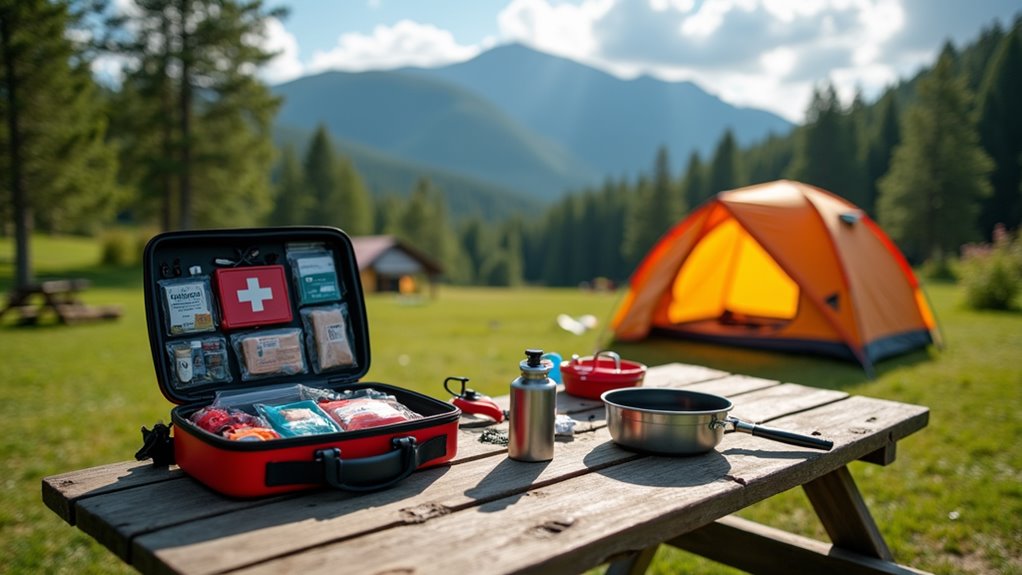
Three types of injuries can turn your camping trip into an emergency—cuts, burns, and allergic reactions—so you’ll need a first aid kit that handles all of them.
You’ve got to pack adhesive bandages in multiple sizes, sterile gauze pads, and medical tape for wound care. Don’t forget antiseptic wipes, antibiotic ointment, and tweezers for cleaning cuts and removing splinters.
Include burn gel packets and non-stick burn dressings—campfire accidents happen fast. For allergic reactions, you’ll need antihistamines and an epinephrine auto-injector if you’re prescribed one.
Add instant cold packs, elastic bandages for sprains, pain relievers, and a comprehensive first aid manual. Store everything in a waterproof container that’s easily accessible from your vehicle.
Check expiration dates before each trip and replace used items immediately.
Weather-Appropriate Clothing Layers
Because temperatures can swing 40 degrees between day and night in many camping areas, you’ll need a strategic layering system that adapts to changing conditions.
Start with moisture-wicking base layers—merino wool or synthetic fabrics that pull sweat away from your skin. Add an insulating mid-layer like fleece or down that traps warm air without bulk. Your outer shell should be windproof and water-resistant, protecting you from sudden storms.
Don’t forget extremities. Pack warm socks, a beanie, and gloves—you’ll lose significant heat through your head and hands.
Choose convertible pants that zip off into shorts for versatility. Always bring one extra layer than you think you’ll need. Weather can turn fast in the wilderness, and staying comfortable means staying safe.
Multi-Tool and Basic Repair Kit
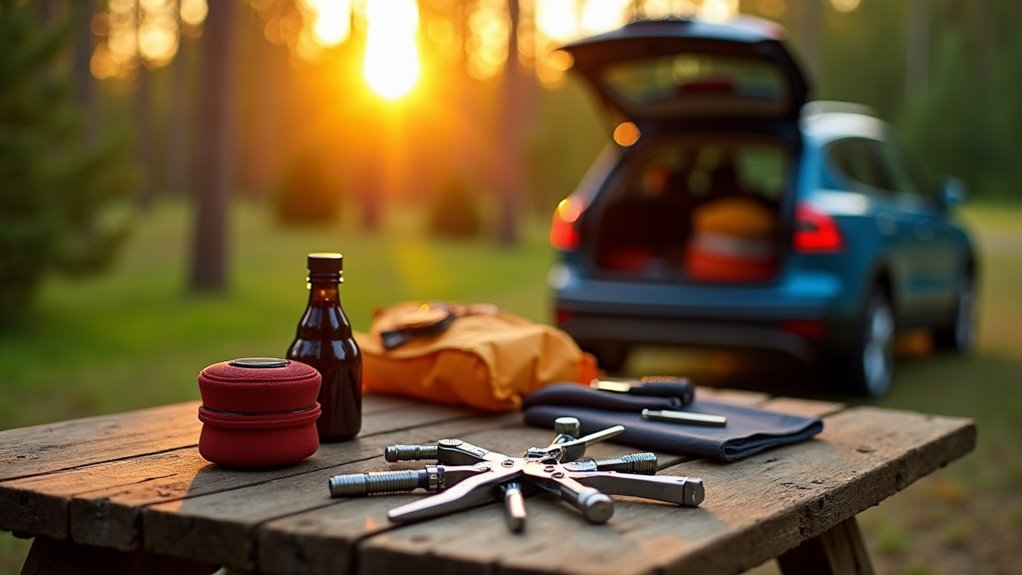
Every seasoned car camper knows that gear failures happen when you’re miles from help—that’s why a quality multi-tool and repair kit aren’t optional luxuries.
You’ll need a multi-tool with pliers, knife blade, screwdrivers, and scissors at minimum. Pack duct tape for quick fixes, zip ties for securing loose items, and paracord for countless emergency applications.
Your repair kit should include tent pole splints, fabric patches, seam sealer, and spare batteries. Don’t forget a small sewing kit with heavy-duty thread.
Add electrical tape, safety pins, and rubber bands. Store everything in a waterproof container that’s easily accessible.
When your camp stove breaks or tent zipper fails, you’ll thank yourself for being prepared with the right tools.
Portable Power Station or Battery Bank
Nobody wants their phone dying when they’re trying to capture that perfect sunrise, or worse, when they need GPS to find their way back—that’s where a reliable portable power station becomes your lifeline.
You’ll need at least 20,000mAh capacity for weekend trips, but I recommend 40,000mAh or higher for extended stays. Look for units with multiple USB ports, AC outlets, and solar charging capability.
My Jackery Explorer 300 has powered everything from laptops to portable fridges through countless adventures. Don’t skimp on quality—cheap batteries lose charge quickly in cold weather and fail when you need them most.
Always pack charging cables for every device, and test your power station before leaving home. Trust me, you’ll thank yourself when everyone else’s gear dies.
Headlamps and Lanterns for Area Lighting
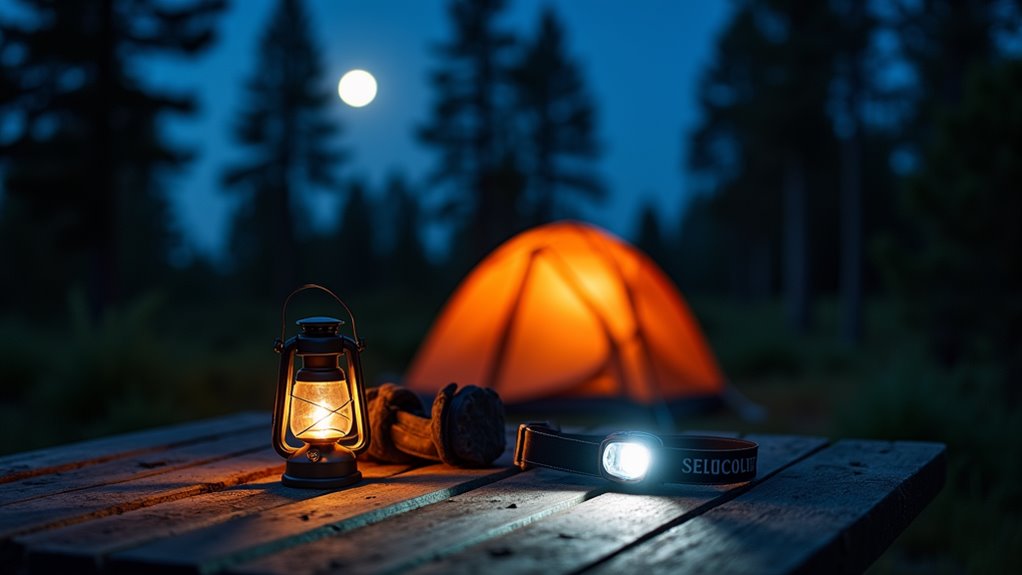
Once your devices are charged, you’ll need proper lighting to navigate camp after dark—and trust me, stumbling around with just your phone flashlight gets old fast.
You’ll want both a quality headlamp and a lantern for different tasks. Headlamps keep your hands free while cooking dinner, setting up gear, or finding that midnight bathroom. Look for models with red-light modes to preserve night vision and multiple brightness settings.
For area lighting, LED lanterns transform your campsite into a livable space. Rechargeable lanterns with adjustable brightness let you create ambient lighting for card games or bright illumination for meal prep. Some models even double as power banks.
Position lanterns strategically—one in the cooking area, another near your tent entrance. You’ll appreciate having dedicated light sources when darkness falls.
Conclusion
You’ve got the essential gear list now, and trust me, these items will transform your car camping from basic to brilliant. Don’t skimp on quality—I’ve learned that lesson the hard way through countless nights of leaky tents and dead batteries. Pack smart, double-check everything before hitting the road, and you’ll create those unforgettable outdoor memories that’ll have you counting down to your next adventure. The wilderness is calling—answer it prepared.
